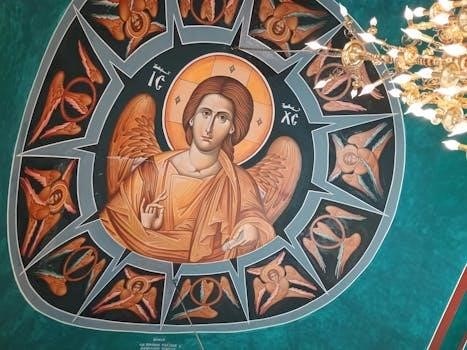Theology of the Body⁚ An Overview
The Theology of the Body, often abbreviated as TOB, is a series of 129 lectures that were given by Pope John Paul II between September 5, 1979, and November 28, 1984; These talks explored human sexuality, marriage, and the human person within the mystery of Christ.
The Theology of the Body is St. John Paul II’s integrated vision of the human person, presented in 129 Wednesday audiences between 1979 and 1984. This profound teaching explores the meaning of our bodies and sexuality, revealing God’s plan for humanity. It is a catechesis centered on understanding the human person within the mystery of Christ, emphasizing the bodily dimension of human personhood.
John Paul II argued that the human body reveals the invisible mystery of God. He asserts that the human body, in its masculinity and femininity, reflects the Trinity, created in God’s image to live in communion. TOB offers answers to fundamental questions about our lives, and it highlights the importance of human freedom within the whole of human nature, revealing God’s wonderful providence for our time. It presents a new vision, unfolding biblical truths about human love and responsibility.
Pope John Paul II and the Theology of the Body
Pope John Paul II deeply reflected on human love, resulting in the Theology of the Body. His teachings offer a fresh vision rooted in biblical truths, exploring the human person and sexuality within Christ’s mystery.
The Genesis of the Theology of the Body
The Genesis of the Theology of the Body lies in a series of 129 Wednesday audiences delivered by Pope John Paul II in Rome, spanning from September 1979 to November 1984. These addresses presented a catechesis centered on the human person as understood within the mystery of Christ. The Pope aimed to explore the bodily dimension of human personhood, encompassing sexuality, marriage, and their significance in light of biblical revelation.
Prior to his papacy, Karol Wojtyła, the future John Paul II, delved into these themes in his book “Love and Responsibility”. This earlier work laid a foundation for the more comprehensive exploration undertaken in the Theology of the Body. His reflections drew from Scripture and offered a unique vision of the human person, challenging conventional understandings of sexuality and relationships; The Genesis aimed to provide answers to fundamental questions regarding human existence.
The Genesis of the Theology of the Body emphasizes the importance of human freedom and the integration of the physical and spiritual dimensions of the human person.

Key Themes in Theology of the Body

Key Themes in Theology of Body
Key themes explore the human person and sexuality, marriage and communion, and redemption and the body. These topics are addressed through St. John Paul II’s Wednesday audiences that took place between 1979 and 1984 in Rome.
Human Person and Sexuality
The Theology of the Body offers a profound reflection on the human person, particularly concerning sexuality. John Paul II emphasizes that the body reveals deeper truths about our identity and purpose. He argues that our sexuality is not merely a biological function but an integral aspect of our personhood, reflecting God’s image.
The human body, in its masculinity and femininity, possesses a specific meaning, making visible an invisible reality. This reality speaks to fundamental questions about our existence and relationships. The Theology of the Body challenges us to understand sexuality within the context of God’s divine plan for humanity.
John Paul II’s teachings invite us to move beyond a purely physical or utilitarian view of sexuality. Instead, he encourages us to embrace a vision of human love rooted in freedom, truth, and self-gift. This approach fosters a deeper appreciation for the dignity of each person and the sacredness of human relationships, ultimately leading to communion and fulfillment.
Marriage and Communion
In the Theology of the Body, marriage is presented as a profound communion of persons, reflecting the very image of the Trinity. John Paul II emphasizes that the marital union is not merely a social contract but a sacred covenant, a total gift of self between husband and wife.
The marital act, when understood within the context of love and responsibility, becomes an expression of this communion, a renewal of the wedding vows in the language of the body. It is a participation in God’s creative power, open to the possibility of new life, and a source of profound unity.
The Theology of the Body challenges the modern world’s often-individualistic view of relationships, highlighting the importance of selflessness, fidelity, and mutual respect within marriage. It calls couples to strive for holiness together, supporting one another on the path to spiritual growth and drawing closer to God through their shared love and commitment, making their relationship a true reflection of divine love.
Redemption and the Body
The Theology of the Body explores how redemption, through Christ’s sacrifice, impacts our understanding of the human body and sexuality. John Paul II argues that sin has wounded our ability to experience and express love authentically, leading to distorted views of the body as merely an object of lust or a source of shame. Christ’s redemption offers healing and restoration.
Through grace, we can begin to see the body anew, as a gift from God, capable of expressing profound love and communion. Redemption allows us to overcome the concupiscence that clouds our vision and to embrace the true meaning of our sexuality, orienting it towards selfless love and the good of the other.
The sacraments, particularly Reconciliation and Eucharist, play a vital role in this process of healing and transformation. They provide the grace necessary to live out the call to holiness in our bodies, allowing us to experience the freedom and joy that come from living in accordance with God’s plan for love and sexuality. This redemption is not just about avoiding sin but about embracing a life of authentic love.

Theological Foundations
The Theology of the Body is built upon a solid foundation of both Scripture and philosophical thought. It integrates biblical insights with the wisdom of theologians like St. Thomas Aquinas, offering a comprehensive understanding of the human person and their purpose.
Biblical Basis
The Theology of the Body is deeply rooted in the scriptures. Pope John Paul II draws heavily from Genesis, particularly the creation narratives, to explore the original meaning of human existence and sexuality. He examines Jesus’ teachings on marriage, divorce, and the call to love as Christ loved.
Key scriptural passages include Genesis 1⁚27, highlighting the creation of man and woman in God’s image, and Matthew 19, where Jesus addresses the indissolubility of marriage. St. Paul’s writings, especially those on the body as a temple of the Holy Spirit, also play a significant role. By returning to these foundational texts, the Theology of the Body seeks to rediscover God’s original plan for humanity, offering fresh insights into relationships, identity, and purpose, all grounded in the revealed word.
Through careful exegesis, John Paul II unveils the profound meaning embedded within these biblical stories, revealing a vision of human love that is both beautiful and transformative.
Influence of St. Thomas Aquinas
While rooted in scripture, the Theology of the Body also draws significantly from the philosophical and theological insights of St. Thomas Aquinas. Aquinas’ understanding of human nature, particularly his emphasis on the integration of body and soul, provides a crucial framework. John Paul II builds upon Aquinas’ teachings on natural law, arguing that our bodies themselves reveal God’s design for human flourishing.
Aquinas’ concept of the human person as a unity of body and soul is central to understanding the Theology of the Body’s emphasis on the significance of the body. Furthermore, Aquinas’ exploration of virtue and the pursuit of the good informs the Theology of the Body’s understanding of authentic love as a self-giving act oriented towards the true good of the other. By integrating Aquinas’ wisdom, John Paul II presents a robust and intellectually compelling vision of human sexuality and its place within God’s plan.

Practical Applications of Theology of the Body
The Theology of the Body offers profound insights that extend far beyond academic discussion, impacting everyday life. It provides a framework for understanding the dignity of the human person, shaping decisions about relationships, sexuality, and family life. In marriage preparation, it offers couples a deeper understanding of the sacrament, emphasizing mutual self-giving and the unitive and procreative dimensions of marital love.
Furthermore, Theology of the Body informs approaches to chastity, not as a restrictive set of rules, but as a liberating path to authentic freedom and love. It provides a positive vision of sexuality, encouraging individuals to embrace their bodies as gifts and to live in accordance with God’s design. Ultimately, its principles guide us towards healthier relationships, a deeper appreciation for our bodies, and a richer understanding of our call to love.
